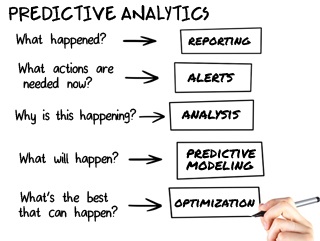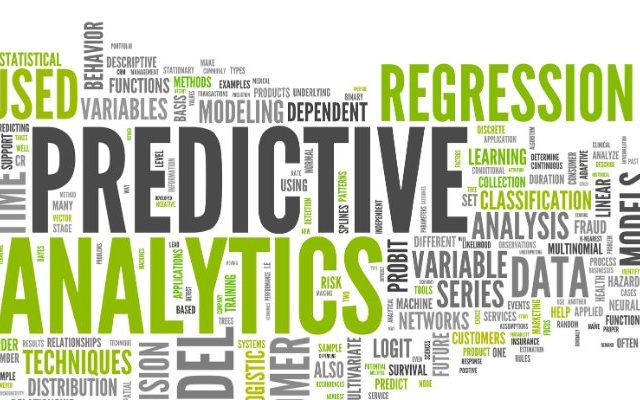Whether you love it or hate it, predictive analytics has already helped elect presidents, discover new energy sources, score consumer credit, assess health risks, detect fraud and target prospective buyers. Predictive analytics is business intelligence technology that produces a predictive score for each customer or other organizational element. Predictive analytics is the use of data, statistical algorithms and machine-learning techniques to identify the likelihood of future outcomes based on historical data.
If you can’t fix it, feature it!
The goal is to go beyond descriptive statistics and reporting on what has happened to providing a best assessment on what will happen in the future. The end result is to streamline decision making and produce new insights that lead to better actions.

Data is a precious thing and will last longer than the systems themselves.
 Predictive models use known results to develop (or train) a model that can be used to predict values for different or new data. The modeling results in predictions that represent a probability of the target variable (for example, revenue) based on estimated significance from a set of input variables. This is different from descriptive models that help you understand what happened or diagnostic models that help you understand key relationships and determine why something happened.
Predictive models use known results to develop (or train) a model that can be used to predict values for different or new data. The modeling results in predictions that represent a probability of the target variable (for example, revenue) based on estimated significance from a set of input variables. This is different from descriptive models that help you understand what happened or diagnostic models that help you understand key relationships and determine why something happened.

To increase their bottom line and competitive advantage using predictive analytics number of organizations are spinning to predictive analytics due to:
- Growing volumes and types of data and more interest in using data to produce valuable information.
- Faster, cheaper computers and easier-to-use software.
- Tougher economic conditions and a need for competitive differentiation.
Predictive analytics are gaining in popularity, but what do you—a manager, not an analyst—really need to know in order to interpret results and make better decisions? There are certain components you need to familiar to understand how it works.
 The Data: Lack of good data is the most common barrier to organizations seeking to employ predictive analytics. To make predictions about what customers will buy in the future, for example, you need to have good data on who they are buying (which may require a loyalty program, or at least a lot of analysis of their credit cards), what they have bought in the past, the attributes of those products (attribute-based predictions are often more accurate than the “people who buy this also buy this” type of model), and perhaps some demographic attributes of the customer (age, gender, residential location, socioeconomic status, etc.).The Statistics: Regression analysis in its various forms is the primary tool that organizations use for predictive analytics. It works like this in general: An analyst hypothesizes that a set of independent variables (say, gender, income, visits to a website) are statistically correlated with the purchase of a product for a sample of customers. The analyst performs a regression analysis to see just how correlated each variable is; this usually requires some iteration to find the right combination of variables and the best model.
The Data: Lack of good data is the most common barrier to organizations seeking to employ predictive analytics. To make predictions about what customers will buy in the future, for example, you need to have good data on who they are buying (which may require a loyalty program, or at least a lot of analysis of their credit cards), what they have bought in the past, the attributes of those products (attribute-based predictions are often more accurate than the “people who buy this also buy this” type of model), and perhaps some demographic attributes of the customer (age, gender, residential location, socioeconomic status, etc.).The Statistics: Regression analysis in its various forms is the primary tool that organizations use for predictive analytics. It works like this in general: An analyst hypothesizes that a set of independent variables (say, gender, income, visits to a website) are statistically correlated with the purchase of a product for a sample of customers. The analyst performs a regression analysis to see just how correlated each variable is; this usually requires some iteration to find the right combination of variables and the best model.

The Assumptions:
That brings us to the other key factor in any predictive model—the assumptions that underlie it. Every model has them, and it’s important to know what they are and monitor whether they are still true. The big assumption in predictive analytics is that the future will continue to be like the past.
To direct, optimize, and automate decisions to improve business processes, the Predictive Enterprise employs predictive analytics. Predictive analytics includes both:
- Analysis of past, present, and projected future outcomes using advanced analytics
- Decision optimization for determining which actions will drive the optimal outcomes, and then delivering those recommended actions to the systems or people that can effectively implement them

Through measuring uncertainty surrounding issues, predictive analytics enables proactive risk management, serving as a guide for refining key decision making processes through controlled, iterative testing of potential actions and their likely intended—and unintended—consequences. By deploying predictive analytics within front-line operational systems, specific organization goals relating to revenue increases, cost reductions, process improvements, and competitive advantages can be achieved.
If a strategy meets a goal: It’s working. If a strategy meets a target: It’s a success.
There is a huge value in learning with instant feedback.
Please add your “comments” below or tweet me your thoughts @refertoAnuj
Article by channel:
Everything you need to know about Digital Transformation
The best articles, news and events direct to your inbox
Read more articles tagged: Featured






